The Moot Hall and My Family
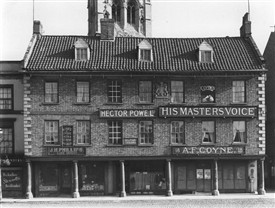
Coyne's Music Shop in the old moot Hall on the north side of Newark Market Place (The tower of the parish church of St.Mary Magdalene may be seen behind)
Bill Coyne
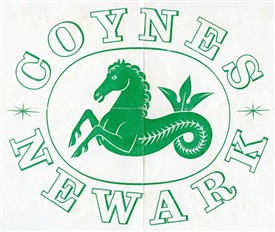
The Coyne's business logo, based on the family Coat of Arms, and designed by my cousin, Douglas Coyne
Bill Coyne
Coyne's Music Shop in Newark Market Place
By Bill Coyne
A Brief History of my Family
The Coyne name comes from Ireland and is a shortened form of Kilcoyne. The Crest on the Coat of Arms is a seahorse. This was adapted by Douglas Coyne and used as a logo for the firm.
The story told down the generations is that at one time there were no “Coynes” in England. The family arrived in the following way:-
A very distant relation of mine ‘William’, who I am supposed to be named after, was employed as a farm hand in Ireland and entrusted in taking some valuable cattle to market. After several Guinness stops it was not surprising that the cattle got lost. He managed to find and sell three or four. Scared of going back to the farm with so little money or maybe having so much in his hands at once, he decided to board the next ship out of the docks as a stowaway to England.
The next record of the family is in March, Cambridgeshire. This was where my grandad A.F. (Arthur Frederick) Coyne was born. He was one of fourteen children. His father a local violinist taught all of them music, so it’s not surprising my grandad played in various bands and orchestras. Just after my father was born in 1900, they moved to Newark. Grandad started several or joined several bands, Abbots, Charles Street, British Legion, Picture Drome and Sherwood Foresters. In time he became Senior Band Master of the four Sherwood Foresters bands and teaching private pupils.
The Sherwood Foresters Regimental band with Bandmaster Arthur Frederick Coyne (front row middle, between drums). Behind him is Frank Coyne, whilst Len Coyne is second from the left on the back row (with red spot above).
Christine Barnes
I am not sure when he started the musical shop in 48 Cartergate, but when my father married in 1924 they lived in the converted Corinthian Lodge at the back of the row of shops. This was also known as the Spiritualist Rooms. The Lodge was reached by a passage over which was a curved stone with Corinthian Lodge engraved on it. I last saw this stone in the Masons Lodge, The Avenue, London Road. My grandad moved to the Moot Hall in 1924, just after my sister was born. My family then moved into the Cartergate shop and in 1932 I arrived. In 1942 grandad died aged 70. We moved into the Moot Hall and I lived and worked there until the firm went into liquidation 1962/63.
Publicity postcard advertising the opening on Wednesday 25th March 1925 of Coynes' new shop at No.18 Market Place, Newark (The Moot Hall). Note that the old shop at No.48 Carter Gate is still listed at the bottom of the postcard
Bill Coyne
The Moot Hall
Built in 1708, it replaced the King’s Hall. The Coat of Arms is not Newark’s but John Holles, Duke of Newcastle. If you look at photos in 1800’s the Hall was already in a bad state, and when I moved there in 1942 aged 10 it was 234 years old, with walls leaning and floors sinking. The owners were Hindley’s music dealers of Clumber St, Nottingham. The building was L shaped; No 17 was Philips Ropes, 17A Midworths Florist, and later Hector Powell Military Tailor. No 18 was our shop but we had 2/3rds of first floor i.e. 17A had no room on this floor. Curry’s rebuilding brought back the elegant front and they must be congratulated, but the inside including the cellars which brought comments in the Newspapers “Not of any interest” have been lost forever. Unfortunately I had major problems in my life at this time and did not take photos, which I now regret.
The Cellars Beneath
5 altogether. The front ones had grates or small windows. These ones were dry and used for living in. They had doors, black leaded cooking range, in fact when I was young Phillips still used theirs as a kitchen. Later we kept fireworks and toys in 17A. I was glad when these were moved to No 20 Market Place. The coal cellar went under the path between us and Porters (A.T. Mays). You can still see where the manhole cover was, fetching coal up two storeys, was one of my jobs. We used the front cellar for charging accumulators collected and delivered in town and surrounding villages. I used to go with my father or my uncles when off school. We also had to repair accumulators using hot pitch; I also learnt how to put new springs in wind up gramophone barrels. These were 5 to 6 inches in diameter and the springs several feet long. The barrels had teeth on one side. The knack was trying to hold it with one hand while feeding the spring in. If the tension got too much and you could not hold it you just had to point it at a blank wall, let it go and duck!
We charged hundreds of accumulators but only had one fire which was quickly put out, but we did drop an acid carboy down the stone steps. The acid ate all the wooden bench legs away and I will always remember the smell of pitch, acid and graphite grease.
The middle cellar was just storage. From there was a long passage with places for lights or candles, this lead to the back cellar. This was dark and dank (no grates or windows). This was of different construction to other cellars, more stone than brick with arched roofs in alcoves. In 1934 a new room was built behind the shop taking place of a yard and store room so most of the cellar ‘ceiling’ was the wooden floor of the extension. There is a plan of this in the museum which shows the cellar (I have a photocopy), and also a paper stating that the cellars which were supposed to be cells, were filled in the mid 1960s. My father was told by his father that ‘items’ from the ‘cells’ had been given to the museum in the 1800’s, but I can find no proof of this. Some finds were discovered during Curry’s rebuild of the site. I don’t know what these were.
I have seen though, in the part of the back cellar which went under the side Church Walk (like a coal cellar), the floor of which was several inches lower than the remainder. There were large iron hinge pegs on the entrance to the alcoves, that large gates would have hinged on. Also marks on walls made by metal objects? Now these alcoves may just have been gated areas for security, wine, food etc., but may have been the internal remains of the 1708 building or before who knows? You stepped over a stone step to reach this cellar and inside was a long brick trough with stone slabs on top.
In one corner of the cellar was a bricked up arch. This was facing Church Street, newer bricks than the wall. It was about 4ft high. We always thought it might be part of the supposed tunnels mentioned in Cornelius Brown's History of Newark and recently in Ghosts & Legends of Newark by Rosemary Robb. Old maps show two rows of building here, and the bricked up doorway might just have lead to cellars of long gone buildings, but when I think how many times the roads have collapsed at the corners of Middlegate, Kirkgate, Barnbygate and Cartergate in my life and we are told “Its only the sewers”, is it? I think of the tunnels.
Above: Coynes' first motorised (3-wheeled) delivery vehicle. Pictured outside the shop in the early 1930s are my uncle Jack Maidlow (left) and Len Coyne on the right. The van was painted in Sherwood Foresters colours - green with red panels and gold lettering. The picture left also shows Len Coyne in the early 1930s beside a selection of 'brand new and boxed' His Master's Voice table-top valve wireless sets. One top of the pile is a box containing a separate 'all purpose' loudspeaker.
Ground Floor of the Moot Hall
Stone steps lead from cellars to the ground floor and shop area. When I was young it was full of records and musical instruments hanging above counters which were full of strings for violins, reeds for saxophones, mouth organs etc. Our stock changed over the years to TV, radio, cycles, electrical toys, hardware and even ice creams and sweets. Many people would know my Grandma who had a leg iron and because she was restricted by this, she sat on a stool taking cash at the till. Most of the family could teach music and there was an audition room which later became an area for records and toys. One thing that was still there in the late 1950s was a bell push and sign which gave the numbers of rings for each member of staff who had to stay in the back room until granddad called them forward - all ‘properly dressed’ of course!
Coynes' trade stand at an exposition of local business in the car park off London Road, Newark, in 1955
Bill Coyne
First Floor of the Moot Hall
A nice large staircase with a well about 12ft across, went to all floors except the attic. In the museum there is a paper which states, “two stair cases were removed from the King’s Hall and built into the new hall (Moot?)”. I wonder if this was one of them or whether it was added in the1800s when it was converted to shops, but on the first and second floor there were landings or galleries which were blocked off. These would seem to have run the length of the building at one time on this floor. Two of the front windows were the living room. This was where we had parties and musical evenings. When grandma and granddad were alive, the children had their party in the kitchen and were only allowed in the living room to get your present from the grandparents; not that they were stern or frightening but that was how it was with such a large family, possibly 20 or 25 at a time.
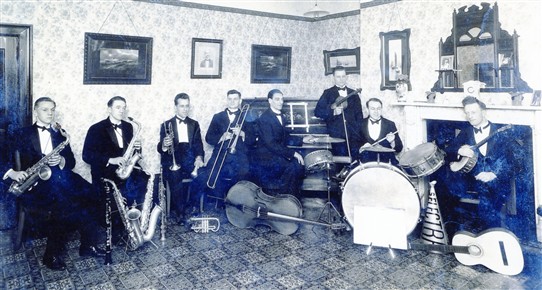
Len Coyne's "Selectra" Band c.1930 pictured in what became the Coyne family's living room on the first floor of the Moot Hall. Photographed in a room above the shop, the picture shows Len Coyne (second from left) and Frank Coyne on drums. Arthur Coyne is 4th from left. Note the loud-hailer (next to the bass drum) which was used by the vocalist in these days before microphones.
The next two windows were the show room when TV first came. We had it full of people watching Royal Weddings and Football, Cricket etc. I expect it was the same when gramophones and radios first arrived. At Christmas there was always a large family party. We would take the geese or turkey to the bake house on Appletongate (Nicholson’s) as they were too large to cook. After we would play games like Charades or murder something like Cluedo, but not on a board. We would all draw cards, one would be the murderer, and he or she was the only one not to tell the truth. The others drew places to hide and one would be the victim and one the detective. With the shop, 5 cellars, 12 or so rooms to hide in it was quite a game so the small children had to go with a grown up. At a set time you had to close your eyes and count up to 50. This gave the murderer time to choose the victim and back to his or her original place.
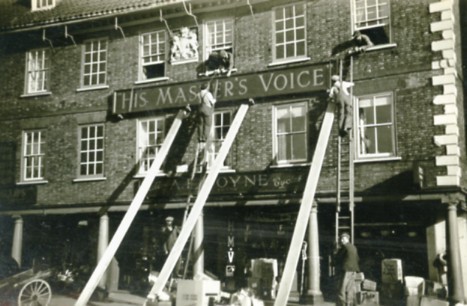
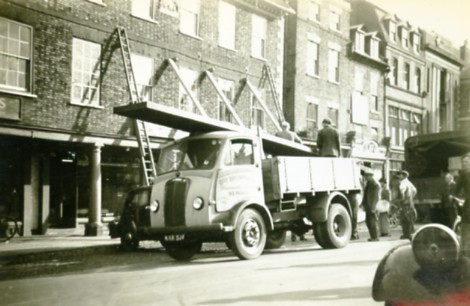
The two photos above show the removal, in 1954, of the large 'His Master's Voice' sign which adorned the front of the the shop for many years. We had to take the sign down because of objections over intrusive sinage on shops in the Market Place.
Bill Coyne
Kitchen Facilities in the Moot Hall
This was at the back, and had a black leaded range smaller than the one in the cellar, gas cooker and a bath that was boxed in and covered with a wooden lid. It always had tins and packets of food on top, as we had resident mice in the cupboard. My mother did not like them so refused to put the food in. We tried to poison them but my father said it only made them tame. When you opened the cupboard doors they came to look at what you were putting in for them. It was a problem to clear the bath top for use. One use I had for it was to soak drum skins in and when these were flexible refit them on to the drums using tools much like tyre levers, but mostly I used spoons and forks. I think my mother had the best collection of bent cutlery in Newark.
The Showroom on the first floor c.1925. Gramophones, anyone?
The Second Floor in the Moot Hall
There were 3 bedrooms and these had the worst floors. My bedroom was at the back and if you could get used to the church clock and bells; also Stennett’s printing works which made the room shake with their printing machines running on a pulley and belt system, you might get to sleep. Later I had a front bedroom; also from this floor was the door and stairs to the attics.
Annie Coyne in the Record department downstairs. All those 78s!
The Moot Hall's Attics
This was my world, my playground. I had all my books and toys up there. I ran a library at school charging one old pence per week for loan of a book and a card system like a real library. We did not want uninvited visitors so I rigged up a bell on a string that would ring when the door was opened, but this did not always work. Later I had a brass strip under a loose stair tread connected to an electric light and bell. This was much better.
My sister’s husband Percy Swallow made wooden toys. He was an old type joiner. Everything must be just so the toys would last forever, wheelbarrows, rocking horses, farms, castles etc. He made me a desk. This was passed on to my son and it is not many years ago that it was still on the go. When older my friend, Jeff Kemp, and I had an ‘O’ gauge model railway in the attics we got into trouble for making holes in the walls, so the attics were my playground/workshop but the servants must have lived in them originally. There was a small door that lead onto the tiny roofspace where pulleys and ropes made an arrangement for drying washing.
Florence Coyne in the musical instrument department c.1925
Around the Square - people I knew
First the market did not close so early. There seemed to be much more going on. The market place and other streets had more people living above or behind the shops etc, even up to the late 50s. In my very young days the market lit up at every night, and at Christmas it seemed a magic place to me, but later when we had a stall outside the shop it was not so magical standing in the cold and rain. But at least the stalls were taken down and away on trailers pulled by a tractor. It can be pleasant when empty.
Next door was George Porter No 19 (now Thomas Cook). They had a board on the wall advertising Pills and Potions (now in museum). "Pink pills for Poorly People" was my name for it, many courting couples used it to lean against, including me, over the years. Porters sold most things loose not pre-packed.
Hunters was at No 20, now Skipton Building Society. Later this was Ken Coyne’s toy shop, there used to be a metal ring in the cobbles but I don’t know what it was for.
Wing-Tavern, no longer in trade, was one of the family’s watering holes run by the Miss Barretts, later Les Fairhall. I was allowed in the living rooms and my drink was Vimto and Smith’s crisps with the Blue Salt Bag.
No 29 was Stanley Porter’s, now G H Porter Provisions, as today it sold bacon and coffee.
No 32 Mason’s Grocers, now Boots the opticians.
No 33 Noble’s Pie Shop, now Thomson’s Travel, more goodies and just down the Arcade, Freddy Watson used to sell tobacco to my father, I had to fetch them.
No 34 White Hart as today. David and Sheila Kerridge who I think were near my age, and playing in the yard. Later with the town at war it was the meeting place of servicemen from many countries and I remember the bar ceiling covered with foreign money.
Bainbridges, now W H Smith. They still had an old type haberdashery counter. I think a man called Stan Varnell lived there and could help you with memories of the shop.
Saracens Head Yard, now Barclays bank and the Works. There was a talking parrot sitting outside at one time which knew quite a few swear words. The late Alf Baxter who had taxi and garages there wrote to me about 10 years ago, on people of his early years. I remember his office was like something out of Dickens dark and tall desks. I used to play with some children in a cottage but I can’t remember their names. I used to go with my dad to Bert Southerington for a hair cut.
Clinton Arms Hotel, now Santander and Bonmarché. A Mr Lawrence kept it for many years and it was a popular meeting spot, coffee under the glass roof, yard full of cars, garages for the guests, now like the Saracens Head, dead at night.
Pipers Bazzar, now Thorntons. Also used to be at No 20 before my time. Later it was near Clinton Arms with my pocket money I bought cheap toys there before we sold toys. Later it became Grahams and then Woodhouse furniture who I worked for, in 1992 it was Rumbelows.
Oldhams Bakery Shop & Large Café/Tea Rooms “Blue Room”, now Greggs. In 1983 there was still “By Royal Appointment Sign”. After Oldhams had closed, before this I think it was Smiths Gunshop.
Town Hall. We used to go to many of the dances held there by various organisations. My mother and father would be invited but gave my girlfriend and I the tickets instead. We went as Mr and Mrs Coyne and were sometimes announced at the posh dances. The market hall and butter market was a jumble of shop and stalls where you could browse etc, and Linneys cafe which was also one time in a tent on the market. What have they done to the market hall with the modern shops?
Cherringtons Chemist, now a card shop. A Mr Healey was always helpful with minor ailments.
The Old Queens Head. Another watering hole of the family, again I was allowed in the living quarters until old enough for the pub and drinking, darts and dominoes. I remember the Smiths (Mabel) and Scotts kept it, now some of the interior is in Millgate museum I think?
Ernest Daybell. Mr Daybell seemed never to change. His butchers shop is there still. We bought an old Austin Van off him. I can see him now and Mr Ash of the Bakery in Ashs Yard (now gone). In 2011 the shop is Porter Bros Finest Meats.
Old Currys Block now Toni & Guy. I remember Herbert Trickett. He was some 20 years older than me but did bike repairs etc. I bought my first Hornby Dublo train from Currys. When in my teens, my second wife worked for Currys and we were in competition, neither shop would close until the other shop showed signs of closing by taking in some of the cycles we had outside, we still lent goods to each other. Business had a different atmosphere in those days, not such a hard sell. We went our own ways, married, lost our partners then we met again. When Currys took over and rebuilt the Moot Hall I used to pick her up from work. I had to wait in the staff room, one of whose windows was my old bedroom. I felt like a ghost watching the same view as a child to young man. It had not changed so much, but is empty at nights compared with the hustle and bustle of times when more people lived there and two hotels with people coming and going. I expect every generation feels like this at times.
Text copyright Bill Coyne, 1992